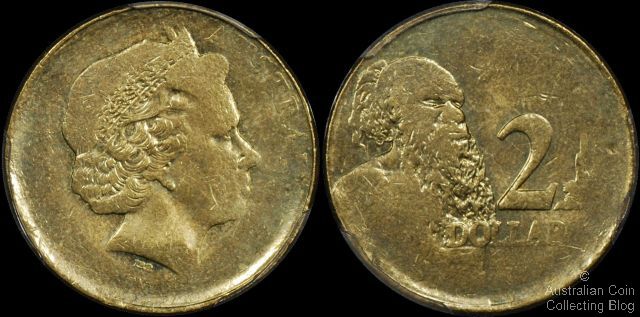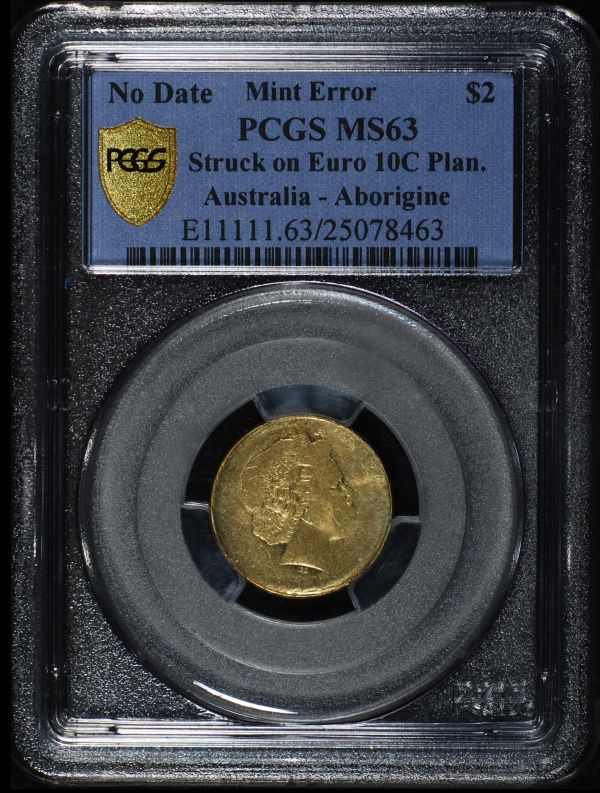Written by The Australian Coin Collecting Blog published in September 2012 Australasian Coin and Banknote Magazine.

Figure 1 (left), Figure 2 (right)
The Australian $2 coin shown in Figures 1 and 2 was purchased on eBay in 2006 and is just a little different to the $2 coins we're all used to getting in our change. The design on both sides of the coin is weak and it's impossible to determine the date. The planchet is considerably underweight at 4.1g instead of the 6.6g it should be.
Firstly we think it's important to disregard post mint damage as a reason for the appearance of this coin before attempting to discover the real reasons behind it. PMD is damage that has occurred to a coin after it left the mint, in the case of this coin, the Royal Australian Mint. One type of post mint damage that could cause an underweight planchet and apparent strike weakness is exposure to acid. However, in our experience exposure to acid causes a uniform level of damage across the surface of the coin, and in this case there are areas of the coin that show full detail such as in the Queen's hair and the Aboriginal's beard. So we are not inclined to think that this coin has been exposed to and damaged by acid.
Could this coin be a counterfeit? We have seen many counterfeit $2 coins. They usually have crude depictions of the Ian Rank-Broadley obverse and the Aboriginal reverse design. To our eyes this coin does not match the counterfeits we have seen.
Another possibility is that the coin was struck through oil or grease, but this usually wouldn't result in the same uniform weakness on both sides of the coin. So we can rule that out. One last explanation could be that the coin is simply a weak strike due to low strike pressure. This could be by design as a die adjustment strike or by accident due to a press malfunction. In either case a weakly struck coin would look pretty much like the coin that we see here.
But is that all there is or could there be more to the story?
The underweight planchet is the key to the puzzle and the reason for the evident strike weakness. It could be that the underweight planchet this coin was minted on was a stray blank intended to be a coin for another country. Perhaps it mistakenly slipped into a barrel of blanks prepared overseas and was then imported to the RAM. We've seen it before more obviously with a Mob of Roos $1 struck on a Venezuelan Bi-metal planchet (Australian Coin and Banknote Magazine, April 2010). It has also happened with at least two 20c coins being struck on foreign bi-metal planchets. So, is this another example of an Australian coin being struck on a foreign planchet? This $2 coin weighs 4.1g, funnily enough the exact weight of a 10 cent Euro coin. The possibility that this $2 was struck on a Euro 10c is all the more plausible because the supplier of coin blanks to the Royal Australian Mint is the Poongsan Corporation of South Korea and they are also a major supplier of coin blanks to the global market including the Eurozone.
If this were to be an Australian $2 struck on a foreign planchet then it would be neccesary to check that it's composition is different to the aluminium bronze alloy used to make normal Australian $2 coins. This alloy comprises 92% copper, 6% aluminium and 2% nickel. It is not hugely different to the alloy that the Euro 10c is made from and to our eyes appears visually identical. The Euro 10c planchet is made from an alloy known as Nordic Gold which comprises 89% copper, 5% aluminium, 5% zinc and 1% tin.
To confirm our theory we recently sent the coin away to the Professional Coin Grading Service (PCGS) in the USA for grading and attribution. We're happy to say that they have agreed with what we'd suspected having conducted a non-destructive XRF metallurgical test on the coin which confirmed it is in fact struck on a Nordic Gold planchet. With both the composition and mass matching that of the 10 Euro Cent they had no qualms in labelling it as an Australian $2 struck on a Euro 10 cent planchet. They have slabbed and graded it as MS63 which is equivalent to Uncirculated under Australian grading standards. You can see the $2 in it's PCGS slab in Figure 3.
As far as we are aware this coin is the discovery piece for this particular type of $2 error. However, based on some news that we've heard just recently more of these interesting error coins could well be surfacing in October this year in Downies Auction #312. This suggests to us that keen eyed collectors out there should be checking any strange looking $2 coins for this type of mint error.

Figure 3
Update: January 2013 More Australian Two Dollar Error Coins Struck on Euro 10c Planchets
Posted by harrisk at September 15, 2012 8:39 PM
Subscribe to our Newsletter


